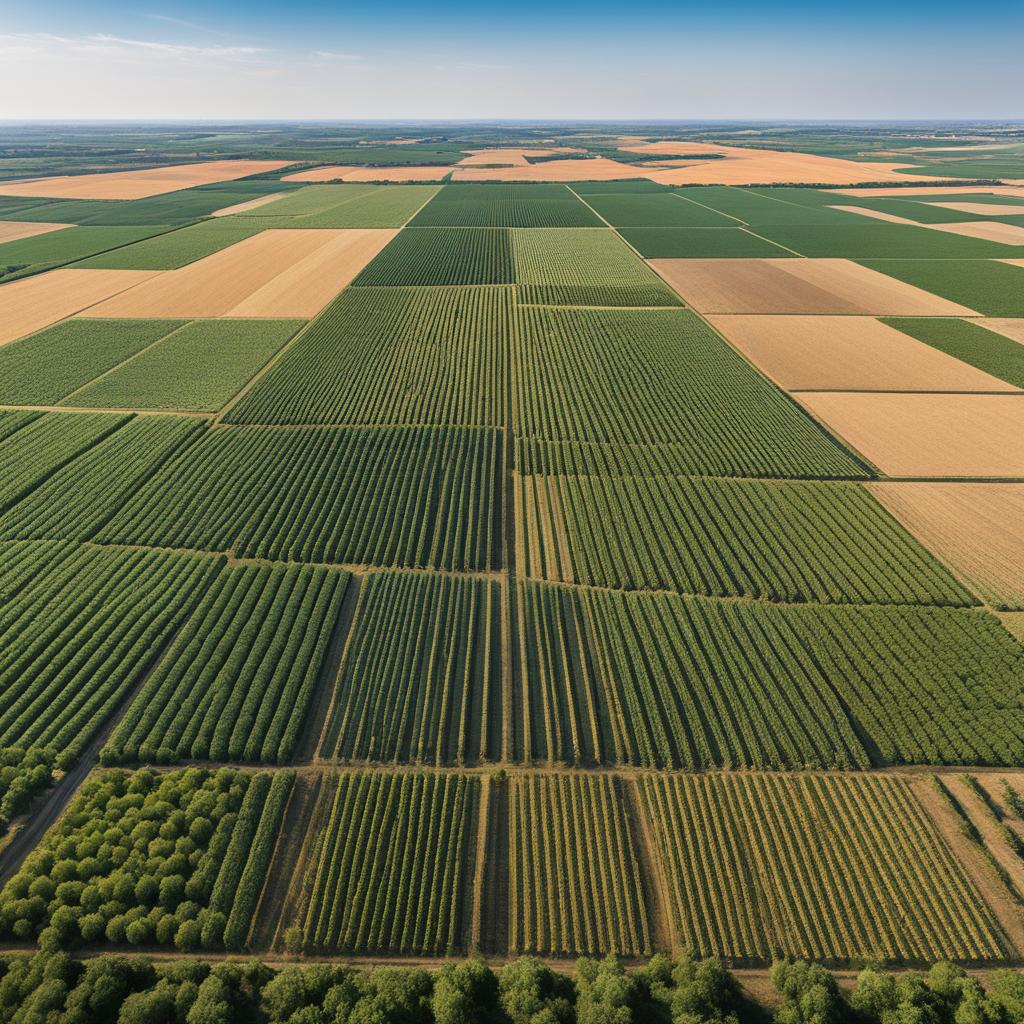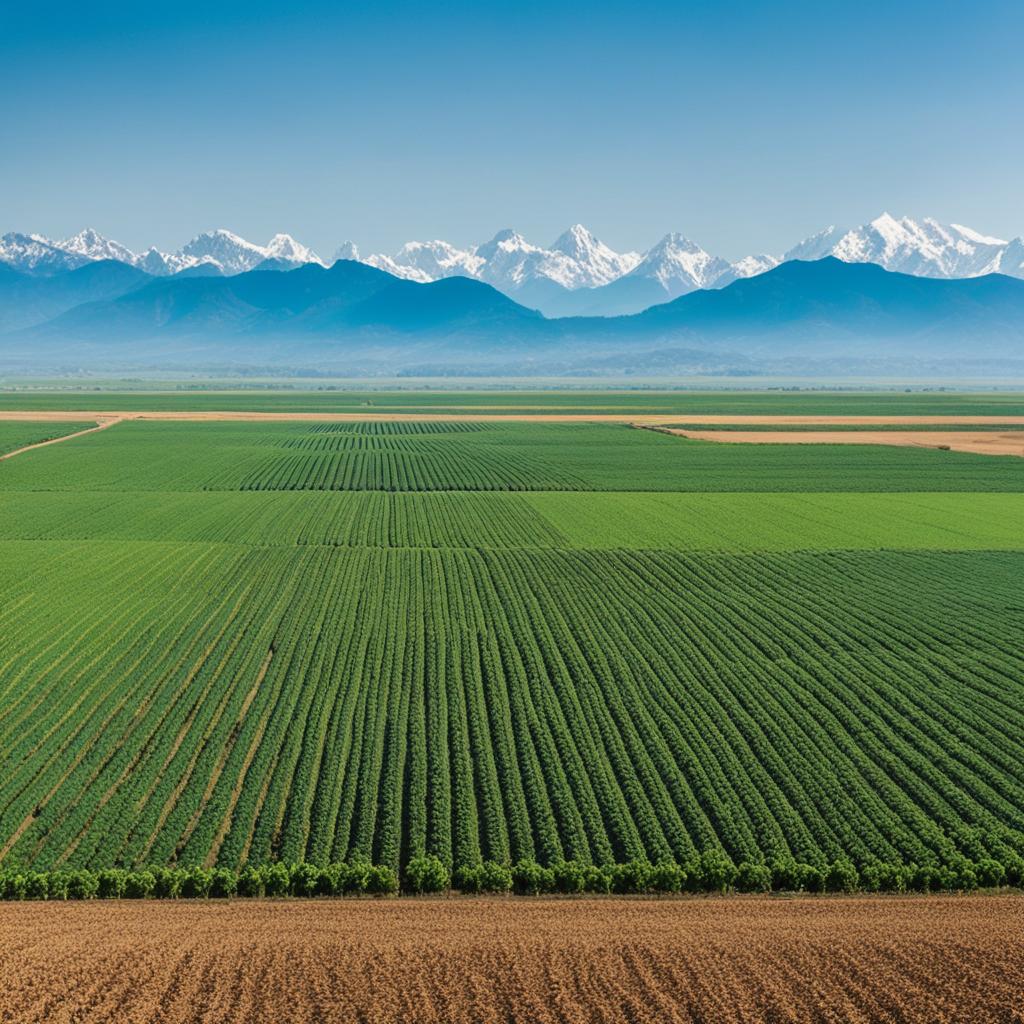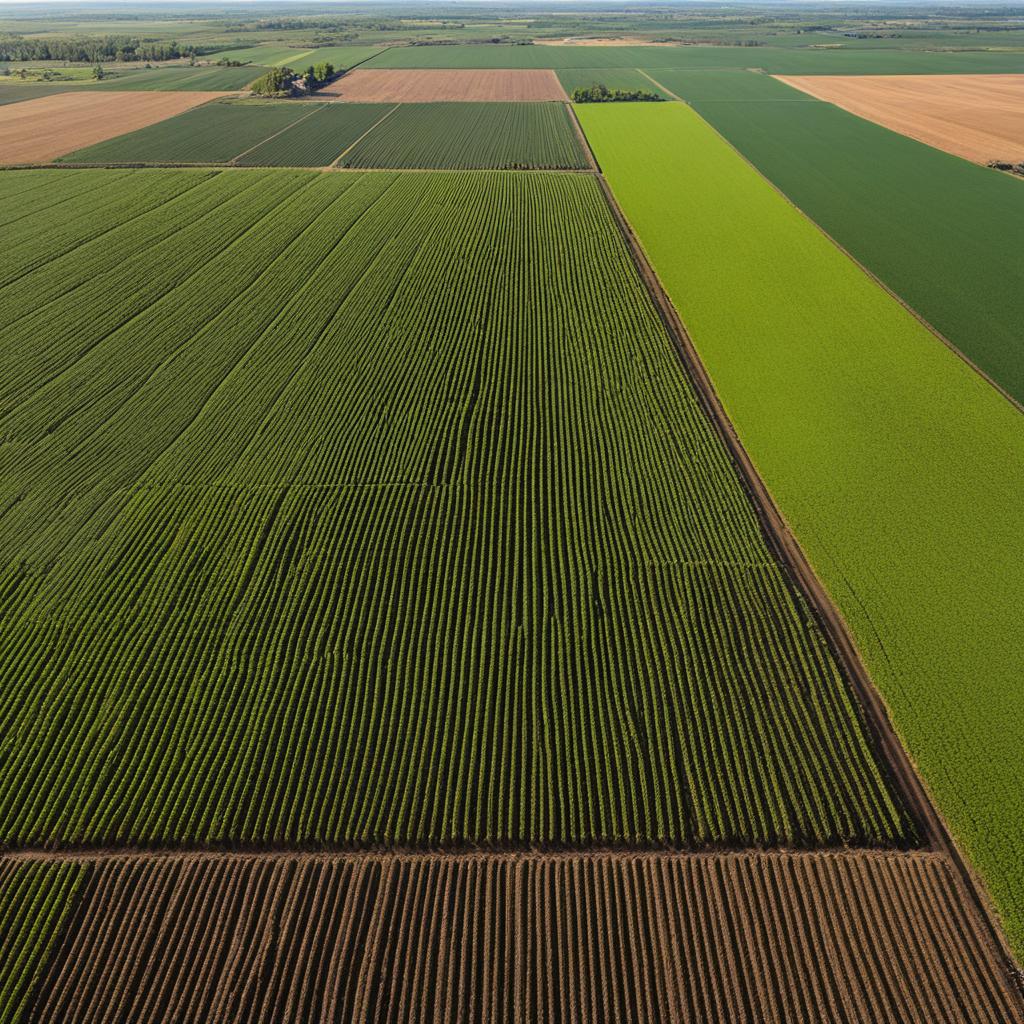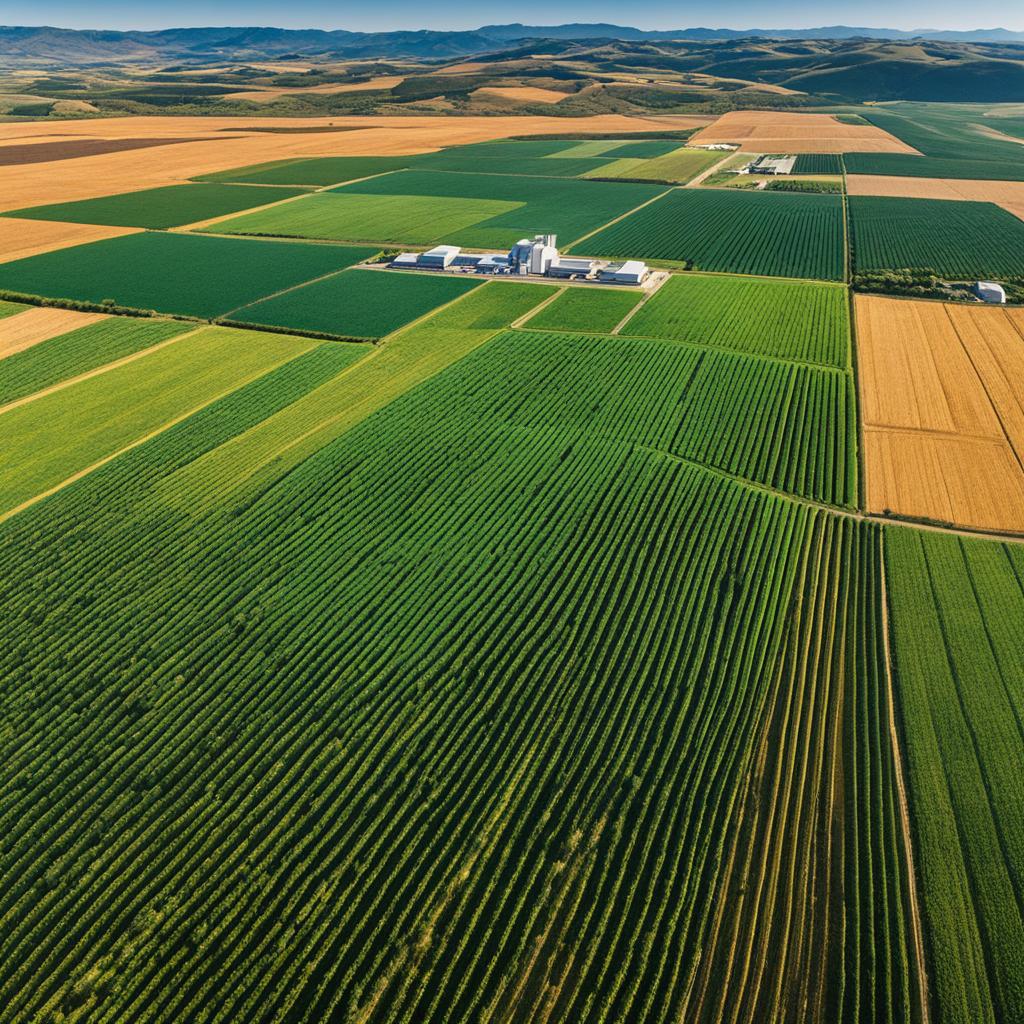Are you considering investing in farmland? As an investor, it’s essential to explore diverse investment opportunities that offer both stability and growth potential. Farmland investment is one such option that has gained traction in recent years. In this article, I will delve into the world of investing in farmland and evaluate whether the returns are truly worth it.
Key Takeaways:
- Investing in farmland can provide long-term appreciation and serve as a hedge against inflation.
- Historically, farmland has generated average returns of around 12.5%, outperforming many other asset classes.
- Farmland offers benefits such as low volatility, low correlation with other assets, and diversification opportunities.
- Institutional demand for farmland is on the rise, with pension funds, endowments, and foundations recognizing its potential.
- New accessibility options, such as farmland REITs and crowdfunding platforms, have made it easier for individual investors to participate.
The Benefits of Farmland for Investors
Investing in farmland provides a range of benefits that make it an attractive option for investors. Let’s explore some of these advantages:
Inflation Hedge
Farmland offers a reliable hedge against inflation. As the value of the dollar decreases over time, the price of food and agricultural products typically increases. This rise in prices positively impacts the value of farmland, allowing investors to preserve their purchasing power and potentially benefit from increased returns.
Historically Strong Returns
Farmland has demonstrated strong long-term investment returns. Over the past 50 years, the average annual return of farmland has surpassed inflation by 6.1%. Since 1991, farmland has consistently produced positive returns every year, with an average annual return of 11.5%. These figures highlight the potential for attractive financial gains in the farmland market.
Low Volatility and Correlation
Farmland exhibits low volatility and low correlation with other asset classes. Unlike stocks, bonds, or real estate, farmland returns have historically been less volatile. This stability makes it an appealing option for risk-averse investors who seek reliable, predictable income and capital appreciation.
Diversification
Investing in farmland provides diversification benefits. Farmland is an entirely different asset class compared to traditional investments such as stocks and bonds. By including farmland investments in a diversified portfolio, investors can reduce risk and potentially enhance overall returns.
Farmland offers an excellent opportunity for investors to diversify their portfolios and mitigate risk while pursuing attractive returns.
Now, let’s take a closer look at the historical performance of farmland investments.
| Key Statistics | Average Annual Returns |
|---|---|
| Returns vs. Inflation (past 50 years) | 6.1% |
| Average Annual Returns since 1991 | 11.5% |
The Rise of Institutional Demand for Farmland
In recent years, farmland investing has gained significant attention from institutional investors. Institutions have recognized the potential of farmland as a stable and lucrative asset class, leading to a rise in institutional ownership of farmland. Currently, institutions own or manage an estimated $26 billion of US farmland, highlighting the growing significance of farmland as an investment opportunity.
“Farmland’s historical performance, low volatility, and inflation-hedging properties make it an attractive option for institutional investors.”
Pension funds, endowments, foundations, and private pension funds are among the many institutions that have embraced farmland investing. These investors are drawn to the historical performance of farmland, which has consistently delivered solid returns over the years. Moreover, farmland’s low volatility provides an attractive contrast to other asset classes that are more prone to market fluctuations.
Institutional investment in farmland has seen remarkable growth in the past decade. In fact, institutional ownership has increased nearly five times in the last 10 years alone. This surge in institutional demand for farmland demonstrates the recognition of its potential as a long-term investment.
Institutional Demand for Farmland by Investor Type:
| Investor Type | Level of Institutional Ownership |
|---|---|
| Pension Funds | 11% |
| Endowments | 9% |
| Foundations | 7% |
| Private Pension Funds | 6% |
The data above highlights the significant presence of institutional investors across various sectors. These investors recognize the value and potential returns that farmland can offer.
Overall, the rise of institutional demand for farmland underscores the increasing recognition of farmland as a viable investment opportunity. With its historical performance, low volatility, and inflation-hedging properties, farmland provides institutional investors with a stable and lucrative asset class that can enhance their investment portfolios.

New Accessibility for Individual Investors
Investing in farmland has traditionally been associated with high upfront costs, making it challenging for individual investors to enter this asset class. Fortunately, new opportunities have emerged, making farmland investment more accessible and inclusive.
One avenue for individual investors to participate in farmland investment is through publicly traded farmland REITs (Real Estate Investment Trusts) and agricultural REITs. These investment vehicles allow retail investors to own a portion of farmland without the need for large upfront investments. By pooling funds from individual investors, these REITs acquire and manage farmland properties, providing investors with exposure to the agricultural sector.
Online farmland investment platforms have also played a significant role in democratizing farmland investing. These platforms offer individual investors the chance to invest in institutional-quality farmland offerings with low minimum investment requirements. These offerings provide diversification and the opportunity to invest in high-quality farmland managed by experienced agricultural professionals.
Table: Comparison of Farmland Investment Options
| Investment Vehicle | Upfront Costs | Investor Type | Minimum Investment |
|---|---|---|---|
| Publicly Traded Farmland REITs | Low | Retail investors | Varies |
| Online Farmland Investment Platforms | Low | Individual investors | Low (typically $10,000 or less) |
Through these innovative platforms, individual investors can benefit from the potential returns and diversification that farmland investment offers, even with limited capital. The accessibility of farmland investment platforms allows investors of all backgrounds to participate in the agricultural sector and potentially reap the rewards of this historically reliable asset class.
By providing opportunities to invest in farmland with lower barriers to entry, publicly traded farmland REITs and online investment platforms have revolutionized the landscape of farmland investing. These advancements have opened doors for individual investors, providing them with a chance to diversify their portfolios and capitalize on the long-term value of farmland.

How to Invest in Farmland: Direct Land Ownership
Investing in farmland through direct land ownership is the most straightforward approach, allowing you to purchase usable cropland or pastureland and generate income by renting it to a farmer or rancher. While this method requires a significant upfront cost, it offers the advantage of full control and potential long-term appreciation of the land.
Land prices can vary, but on average, you can expect to invest around $4,420 per acre in farmland. The return on investment comes in the form of cash rental payments or crop yields, making it an attractive option for investors seeking steady income over time.
The Different Paths to Direct Farmland Ownership
When considering direct land ownership, there are several pathways you can take:
- Purchase existing farms via sale-leaseback transactions: By acquiring established farms with existing tenants, you can start generating rental income immediately. This approach offers stability and a potentially smoother transition into farmland ownership.
- Buy existing farms and lease them to new tenants: This option allows you to choose the tenants and lease terms, giving you more control over the management of the farmland. However, it also involves more active involvement in finding and screening tenants.
- Acquire non-agricultural land and convert it to farmland: This approach involves purchasing non-agricultural land, such as vacant lots or unused commercial properties, and converting them into productive farmland. It can be a more complex and time-consuming process, but it offers opportunities for value creation and diversification.
Each option has its pros and cons, and the right choice depends on your investment goals, risk tolerance, and level of involvement you desire in managing the farmland.
| Method | Pros | Cons |
|---|---|---|
| Purchase existing farms via sale-leaseback transactions |
|
|
| Buy existing farms and lease them to new tenants |
|
|
| Acquire non-agricultural land and convert it to farmland |
|
|
Consider your resources, expertise, and investment preferences when deciding on the best approach to direct farmland ownership.
Note: It’s important to conduct thorough research and seek professional advice to ensure informed decision-making when investing in farmland.

How to Invest in Farmland: Farmland REITs
Investors looking to participate in farmland investments can take advantage of publicly traded farmland REITs. Farmland REITs or Real Estate Investment Trusts acquire farmland properties and lease them out to farmers, offering investors an opportunity to own a diversified portfolio of farmland without the need for direct ownership.
One notable example of a publicly traded farmland REIT is Farmland Partners, which owns and operates high-quality farmland across the United States. They lease their properties to farmers on a long-term basis, generating steady rental income for investors.
Additionally, Gladstone Land Corporation is another publicly traded farmland REIT that focuses specifically on acquiring and managing farmland properties. They lease their land to experienced farmers, ensuring long-term and stable income for investors.

Investing in farmland REITs offers several benefits:
- Liquidity: Farmland REITs are listed on public exchanges, providing investors with the flexibility to buy and sell shares easily.
- Diversification: By investing in a farmland REIT, investors gain exposure to a diversified portfolio of farmland properties across different regions and crops.
- Participation in farmland performance: As the underlying farmland appreciates in value, the performance of the REIT is likely to reflect this upward trend.
Here’s an example of a table that showcases the performance of selected farmland REITs over a five-year period:
| Farmland REIT | 5-Year Average Annual Return |
|---|---|
| Farmland Partners | 7.5% |
| Gladstone Land Corporation | 9.2% |
It’s important to note that past performance is not indicative of future results, and individual investor experiences may vary.
“Investing in farmland REITs allows me to gain exposure to the potential long-term appreciation of farmland without the hassle of direct ownership. I appreciate the liquidity and diversification that these REITs offer, making it a convenient way to be part of the farmland market.” – John, Farmland REIT investor.
So what are the ways to invest in farmland? The article talks about the following methods:
Section 6: How to Invest in Farmland: Farmland REITs. Investors can also invest in farmland through publicly traded farmland REITs. These REITs acquire farmland and lease it to farmers, providing investors with an opportunity to own a diversified portfolio of farmland without the need for direct ownership. Examples of publicly traded farmland REITs include Farmland Partners and Gladstone Land Corporation. Investing in farmland REITs offers liquidity, diversification, and the ability to participate in the performance of farmland as an asset class.

Investing in farmland REITs offers several benefits:
– Liquidity: Farmland REITs are listed on public exchanges, providing investors with the flexibility to buy and sell shares easily.
– Diversification: By investing in a farmland REIT, investors gain exposure to a diversified portfolio of farmland properties across different regions and crops.
– Participation in farmland performance: As the underlying farmland appreciates in value, the performance of the REIT is likely to reflect this upward trend.
Table: Performance of Selected Farmland REITs (5-Year Average Annual Return)
| Farmland REIT | 5-Year Average Annual Return |
|——————————-|—————————–|
| Farmland Partners | 7.5% |
| Gladstone Land Corporation | 9.2% |
Please note that past performance is not indicative of future results, and individual experiences may vary.
Investors who have opted for farmland REITs appreciate the convenience and benefits they offer. “Investing in farmland REITs allows me to gain exposure to the potential long-term appreciation of farmland without the hassle of direct ownership. I appreciate the liquidity and diversification that these REITs offer, making it a convenient way to be part of the farmland market.” – John, Farmland REIT investor.
How to Invest in Farmland: Crowdfunding Platforms
Crowdfunding platforms focused on farmland investing have emerged, providing accredited investors with access to farmland investments. These platforms, such as AcreTrader, FarmFundr, FarmTogether, Farmland LP, Harvest Returns, and Steward, allow investors to invest in specific farms or portfolios of farmland through crowdfunding.
With farmland crowdfunding platforms, accredited investors can participate in farmland investments with low minimum investments, making it more accessible for individuals who meet the accreditation requirements. Through these platforms, investors can diversify their portfolios and gain exposure to the potential returns of farmland without the need for large upfront investments.
“Investing in farmland through crowdfunding platforms allows me to diversify my portfolio and access the potential benefits of farmland ownership without the need for significant capital. I appreciate the transparency and ease of investing that these platforms offer.” – Emily, accredited investor
Crowdfunding platforms provide detailed information about the farms or portfolios available for investment, including factors such as location, crop type, historical performance, and expected returns. This allows investors to make informed decisions based on their investment goals and risk tolerance.
Benefits of Investing in Farmland through Crowdfunding Platforms
- Access to investment opportunities in farmland that were previously unavailable to individual investors
- Diversification of investment portfolio with an asset class that has low correlation with traditional stocks and bonds
- Transparency and visibility into the performance and management of the farmland investments
- Potential for attractive returns driven by cash flow from crop production and long-term appreciation of farmland values
Investing in farmland through crowdfunding platforms offers a unique opportunity for accredited investors to participate in the agricultural sector and potentially benefit from its long-term growth. However, it is important for investors to carefully evaluate the specific opportunities offered on each platform, considering factors such as the track record of the platform, the management team’s expertise, and the underlying farmland assets.
Comparison of Farmland Crowdfunding Platforms
| Platform | Minimum Investment | Types of Investments | Geographic Focus |
|---|---|---|---|
| AcreTrader | $5,000 | Individual farm offerings | United States |
| FarmFundr | $10,000 | Individual farm and portfolio offerings | United States |
| FarmTogether | $15,000 | Individual farm offerings | United States |
| Farmland LP | $50,000 | Farmland funds | United States |
| Harvest Returns | $5,000 | Individual farm offerings | Global |
| Steward | $5,000 | Individual farm offerings | United States |
Investors should conduct their own due diligence and consult with financial advisors before making any investment decisions.
Factors to Consider When Investing in Farmland
When investing in farmland, there are several important factors to consider in order to make informed investment decisions. These factors include:
The Choice of Crops
Different crops offer varying levels of risk and return. It is important to carefully evaluate the potential of different crop options and their fit with your investment goals. Permanent crops, such as orchards or vineyards, can provide higher returns but may take longer to reach full maturity. On the other hand, row crops like corn or soybeans can provide more immediate income but often have lower returns in the long run. Investing in a mix of crops can help mitigate risks and maximize returns.
Operating Structures
The operating structure of a farmland investment is another crucial consideration. Lease agreements offer stability as they provide rental income and establish a fixed relationship between the landowner and tenant. However, lease agreements can limit profit potential if the rental rates are fixed. On the other hand, direct management contracts allow investors to participate in commodity markets and potentially capture higher returns. However, this operating structure can be more volatile as it exposes the investor to market fluctuations. Understanding the benefits and drawbacks of each operating structure is essential in aligning your investment objectives with the appropriate strategy.
Other Considerations
Additional factors to consider include the location of the farmland, as different regions have varying suitability for different crops. Local climate, soil quality, and access to water sources can impact the potential success of your investment. Additionally, it is essential to evaluate the overall market dynamics, including supply and demand factors, regional agricultural policies, and evolving consumer preferences, which can all influence the profitability and long-term prospects of your investment.
By thoroughly evaluating these factors, you can optimize your farmland investment and increase your chances of achieving successful returns. Remember to consult with a qualified agricultural professional or financial advisor who can provide insights based on your specific goals and circumstances.
| Factors to Consider When Investing in Farmland |
|---|
| The Choice of Crops |
| Operating Structures |
| Other Considerations |
Historical Performance of Farmland
When considering investment options, understanding the historical performance of farmland is essential. Over the years, farmland has consistently delivered strong returns and demonstrated remarkable appreciation.
Farmland investment returns have consistently outpaced inflation, with average annual returns exceeding 6.1% over the past few decades. This indicates the potential for long-term value appreciation and underscores the attractiveness of farmland as an investment.
Furthermore, farmland has consistently produced positive returns every year for the past three decades, surpassing the performance of many other asset classes. This consistency is a testament to the stability and reliability of farmland as an investment.
To put it into perspective, recent years have seen a significant increase in farmland values. Land prices have appreciated by an impressive 12.4%, highlighting the potential for substantial returns. Investing in farmland can provide investors with an opportunity to capitalize on this upward trend in land values.
In summary, the historical performance of farmland speaks for itself. With its strong returns and consistent appreciation, farmland has proven to be a lucrative investment option for those looking for long-term value appreciation.
| Key Points | Benefits |
|---|---|
| Farmland investment returns | Outpaces inflation |
| Historical farmland performance | Consistently positive returns |
| Farmland appreciation | Land prices increase by 12.4% |
Risks and Challenges of Farmland Investing
Investing in farmland, like any other investment, comes with its fair share of risks and challenges. It’s important to be aware of these factors to make informed decisions and manage your investment effectively. Here are some of the key risks and challenges associated with farmland investing:
- Fluctuations in Crop Prices: The prices of crops can be volatile, influenced by various factors such as supply and demand, weather conditions, and changes in consumer preferences. These fluctuations can impact the profitability of your investment and affect short-term returns.
- Weather Events: Natural disasters, such as droughts, floods, and storms, can have devastating effects on crop yields and farmland productivity. Climate change further increases the risk of extreme weather events, posing challenges for farmers and farmland investors alike.
- Government Policies: Changes in government policies, subsidies, regulations, and trade tariffs can significantly impact the agricultural industry and the profitability of farmland investments. Political stability and policies that support agriculture are crucial for the success of farmland investments.
- Market Conditions: The overall economic conditions, interest rates, inflation, and global market trends can influence the demand for agricultural products and farmland prices. Market volatility and uncertainty can affect the value of your investment.
- Land Management: Successful farmland investing requires effective land management practices, including soil management, irrigation systems, pest control, and crop rotation. Inadequate land management can lead to reduced yields, lower profitability, and increased costs.
- Tenant Selection: Finding and selecting reliable and experienced farmers or tenants to lease your farmland is crucial. Poor tenant selection can result in issues such as non-payment of rent, damage to the property, or mismanagement, leading to financial losses.
- Long-Term Commitment: Farmland investing is a long-term commitment, and liquidity can be limited compared to other investment options. It may not be suitable for investors seeking quick profits or those who require immediate access to their investment capital.
Understanding and managing these risks is essential for successful farmland investing. Diversification, thorough research, risk assessment, and partnering with experienced professionals can help mitigate these challenges and increase the likelihood of a profitable and sustainable investment.
Farmland’s Role in Sustainable Agriculture
Farmland plays a vital role in sustainable agriculture and is integral to achieving the broader goal of food security. As the world faces the challenges of climate change and environmental degradation, the importance of sustainable farming practices is becoming increasingly apparent.
Investing in farmland provides an opportunity to support sustainable agriculture initiatives, such as regenerative farming and carbon sequestration. Regenerative farming practices focus on improving soil health, biodiversity, and water quality, while reducing the use of synthetic inputs and enhancing ecosystem services. These practices not only contribute to the sustainability of farmland but also help mitigate climate change by sequestering carbon in the soil.
By investing in farmland that implements environmentally friendly practices, investors can actively contribute to building a more sustainable future. Supporting sustainable agriculture not only promotes environmental stewardship but also has economic benefits. Farms that prioritize sustainability are better positioned to adapt to changing environmental conditions, mitigate risks, and maintain productivity in the long term.
Investing in farmland is not just a financial decision; it is a commitment to sustainable land use and the preservation of our natural resources.
When evaluating farmland investment opportunities, it is crucial to consider the sustainable practices implemented by the farm operators. Look for farms that prioritize conservation techniques, soil health management, water conservation, wildlife habitat preservation, and reducing chemical inputs.
Benefits of Investing in Farmland for Sustainable Agriculture
| Benefits | Description |
|---|---|
| Investment in regenerative farming | Supporting farming practices that restore soil health, enhance biodiversity, and mitigate climate change. |
| Preservation of natural resources | Contributing to the sustainable management of land, water, and wildlife habitats. |
| Food security | Supporting the production of healthy and safe food while ensuring long-term access to essential agricultural resources. |
| Economic resilience | Investing in farms that prioritize sustainability can help mitigate risks and maintain productivity in the face of environmental challenges. |
Investors who are passionate about sustainable agriculture can make a meaningful difference by supporting farmland investments that align with their values. By doing so, they not only stand to benefit financially but also contribute to creating a more sustainable and resilient food system.
Farmland Investment as a Long-Term Strategy
Investing in farmland is a strategic decision that aligns with long-term goals, offering potential appreciation over time. While short-term returns may be modest, farmland’s crucial role in food production, its scarcity, and its ability to serve as an inflation hedge make it an attractive option for those seeking a stable long-term investment.
Successful farmland investors understand the importance of balancing short-term profitability with the potential for long-term value appreciation. Considerations such as cash flow, crop yields, government policies, weather patterns, and regional prospects play a crucial role in optimizing long-term returns. By carefully evaluating these factors, investors can develop a comprehensive investment strategy that maximizes the potential of their farmland portfolio.
Farmland’s role in food production is a fundamental driver of its long-term value. As the global population continues to grow, the demand for agricultural products is expected to increase. Investing in farmland positions investors to take advantage of this trend, as farmland becomes increasingly valuable as a finite resource. Furthermore, farmland’s ability to serve as an inflation hedge provides important portfolio diversification, protecting investors against the erosive effects of inflation over the long term.
“Farmland’s scarcity and its role in food production make it an attractive investment that can deliver long-term value appreciation for investors.”
When considering farmland as a long-term investment strategy, it is essential to evaluate various factors that contribute to its potential value. Cash flow generated through crop production, lease agreements, or rental income should be carefully assessed to ensure the financial viability of the investment. Understanding government policies and regulations related to agriculture and land use is critical in managing potential risks and ensuring compliance.
Weather patterns and regional prospects are additional factors that significantly impact the performance of farmland investments. Droughts, floods, and other weather-related events can influence crop yields and ultimately affect the return on investment. Evaluating the historical weather patterns of a specific region and considering the long-term projections can provide valuable insights into the investment potential of farmland in that area.
Table: Factors to Consider in Farmland Investment Strategy
| Factors | Description |
|---|---|
| Cash Flow | Evaluate the potential income from crop yields, lease agreements, or rental income. |
| Government Policies | Understand the relevant regulations and policies related to agriculture and land use. |
| Weather Patterns | Analyze historical weather patterns and consider long-term weather projections to assess the risk and potential impact on crop yields. |
| Regional Prospects | Evaluate the prospects of the region, considering factors such as population growth, infrastructure development, and proximity to markets. |
Investing in farmland as a long-term strategy requires careful consideration, research, and expertise. However, for those willing to commit to the long term, farmland offers the potential for steady appreciation and a stable investment opportunity.
Conclusion
Investing in farmland presents a compelling opportunity to diversify your portfolio, protect against inflation, and participate in the long-term appreciation of agricultural assets. With a history of delivering solid returns, farmland has demonstrated low volatility and exhibits low correlation with other asset classes. As institutional demand for farmland continues to grow, individual investors now have increased accessibility through farmland REITs and crowdfunding platforms.
When considering farmland investment, it is essential to evaluate various factors such as crop choice, operating structures, risks, and long-term strategies. By carefully assessing these elements, investors can make informed decisions that align with their financial goals and risk tolerance. Farmland investing offers unique opportunities for those seeking stable, long-term returns in the agricultural sector.
Farmland investment is no longer just for large institutional investors. With the emergence of farmland REITs and crowdfunding platforms, individual investors can now participate in this asset class with lower minimum investments. This democratization of farmland investing provides more opportunities for individuals to tap into the potential of farmland and diversify their investment portfolios.
In conclusion, investing in farmland can be a lucrative choice for those looking to diversify their investments, hedge against inflation, and benefit from the long-term value appreciation of agricultural assets. As you explore farmland investment opportunities, consider the various factors at play, such as crop choices, operating structures, and risks. By doing so, you can position yourself for stable and sustainable returns in the agricultural sector.
FAQ
What are the benefits of investing in farmland?
Investing in farmland offers several benefits, including an inflation hedge, historically strong returns, low volatility, low correlation with other asset classes, and diversification.
Why is there growing institutional demand for farmland?
Institutions are recognizing the value of farmland as an investment due to its historical performance, low volatility, and inflation-hedging properties. Institutional investment in farmland has increased significantly in recent years.
How can individual investors access farmland investments?
Individual investors can now access farmland investments through publicly traded farmland REITs and crowdfunding platforms, which offer low minimum investments and make farmland investing more accessible.
What are the different ways to invest in farmland?
Investors can invest in farmland through direct land ownership, purchasing farmland and leasing it to farmers, or through farmland REITs and crowdfunding platforms that provide indirect ownership.
What factors should be considered when investing in farmland?
Factors to consider include the choice of crops, operating structures, risks, and long-term investment strategies. Understanding these factors is crucial for making informed investment decisions.
What has been the historical performance of farmland?
Farmland has historically delivered average annual returns that exceed inflation and has produced positive returns every year. Land values have appreciated significantly over time.
What are the risks and challenges of farmland investing?
Fluctuations in crop prices, weather events, government policies, and market conditions can impact short-term returns. Land management and tenant selection can also pose challenges for investors.
How does farmland contribute to sustainable agriculture?
Farmland investments can support sustainable agriculture initiatives, such as regenerative farming and carbon sequestration, contributing to a more environmentally friendly and sustainable future.
Is farmland investment a suitable long-term strategy?
Farmland investment is primarily a long-term strategy due to its potential for appreciation over time. It offers stability, inflation hedging, and the potential for long-term value appreciation.
Our Friends
- https://www.agriculture.com/understand-the-value-of-investing-in-farmland-7970337
- https://www.fool.com/investing/stock-market/market-sectors/real-estate-investing/farm-investment/
- https://www.forbes.com/sites/forbesfinancecouncil/2024/09/16/the-growth-of-farmland-investing/?sh=e0f7ca21bd15
Money posts:
 A Comprehensive Guide to Farmland REIT Investments in 2024
A Comprehensive Guide to Farmland REIT Investments in 2024
 Are REITs a Good Investment? (2024)
Are REITs a Good Investment? (2024)
 How To Invest In REITs | Real Estate Investment Trusts
How To Invest In REITs | Real Estate Investment Trusts
 17 Best Alternative Investments To Consider in 2024
17 Best Alternative Investments To Consider in 2024
 13 Best Alternative Investments to Boost Your Portfolio in 2024
13 Best Alternative Investments to Boost Your Portfolio in 2024
 13 Best Compound Interest Accounts & Investments (2024)
13 Best Compound Interest Accounts & Investments (2024)
 How to Invest $1 Million Dollars: Strategies and Tips for Growth and Security
How to Invest $1 Million Dollars: Strategies and Tips for Growth and Security
 14 Best Real Estate Crowdfunding Platforms (2024)
14 Best Real Estate Crowdfunding Platforms (2024)

